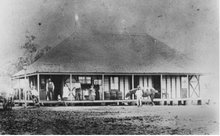Although Queensland ended up with the majority of German migrants to Australia, there were official regrets that European recruitment was not more successful. European migrants had all the ideal qualities mentioned in an earlier post, but were also used to farming in poor conditions and were “energetic, law-abiding and Protestant.” Apparently men with an “intellectual education” and female governesses were discouraged from migration as they showed an unwillingness to work with their hands. Between 1861 and 1893, 45% of migrants to Queensland were agricultural workers or miners, 19% were industrial workers including artisans, mechanics, and labourers, 32.5% were domestic servants and 3.5% were unclassified.
According to Woolcock there was intense competition between countries for migrants with these characteristics, especially from the United States whose unconditional entry and ‘pull’ factor of earlier generations of migration were hard to resist.
British migrants tended to be attracted by the inducements offered by agents such as Henry Jordon. German migrants were more sensitive to the home political climate. Woolcock says that the strategy followed by Jordon in Britain and by Heussler in Germany was to contact men of influence, write articles for newspapers, give public lectures, publish handbills and pamphlets about Queensland and also to answer many enquiries in person. Germans were in general more ignorant about Queensland, there was more official resistance to migration, fears existed about sending female migrants and that migrants would end up as slave or semi-slave labour in the colony.
These concerns were addressed by government involvement not only in the selection of migrants but also in the shipping process. Although official policy was that migrants simply had to be under the age of 60, in order to take part in the land-order system, male migrants had to be under the age of 40 and female migrants under the age of 35. If you paid in full for your passage, you did not need to be screened, but you could not get a land order.
German migrants specifically had to have a character reference from an official who had known them for three years saying that they did not have a criminal record of “riot, assault or drunkenness”, that they hadn’t received “parish relief,” that is, that they were not on welfare and that they were physically and mentally fit. A medical certificate was required for the latter.
Many of these policies are echoed in migration selection today. Governments choose the type of migrant wanted, for example, our current emphasis on skilled labour, and build the requirements around that. In general, migrants are expected to have certain skills, be willing to fit into their new society and to be of good character. Exceptions are made in extenuating circumstances, but the idea of a government picking migrants who will benefit their society continues today. And there is always an element of controversy about such selection.
Tuesday, 14 August 2007
Migrant bureaucracy
Labels:
Australia,
German migrants,
history,
Johann Heussler,
migration,
Queensland
Subscribe to:
Post Comments (Atom)

No comments:
Post a Comment